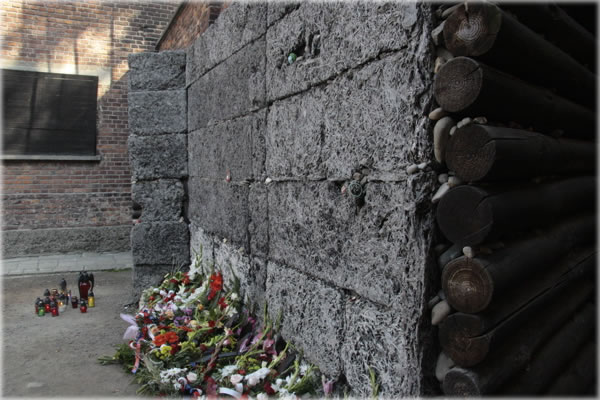 The Death Penalty as Murder | Oct. 7, 2006
Photo Above: Execution wall between Cell Blocks 10 and 11 at Auschwitz. Here, several thousand Poles and Russian prisoners of war lost their lives. Eventually, the executions were moved to other locations, including Auschwitz II - Birkenau. Additional photos are in October cover gallery. Related articles at Eric's blog.
The Death Penalty as Murder | Oct. 7, 2006
Photo Above: Execution wall between Cell Blocks 10 and 11 at Auschwitz. Here, several thousand Poles and Russian prisoners of war lost their lives. Eventually, the executions were moved to other locations, including Auschwitz II - Birkenau. Additional photos are in October cover gallery. Related articles at Eric's blog.
WE ARE accustomed to the story of the Nazis being about mass murder, hearing about thousands at a time gassed and cremated. At the beginning, it happened one at a time, and inside the gas chambers, it also happened one at a time. Was it really the tendency of the Nazis to kill millions that made them what they were, or was it their nonexistent value on the life of an individual?
In the scene above, you are witness to a Nazi execution facility. People such as your mother, your sister, your grandfather, your boyfriend, or yourself, were forced to strip naked, walk barefoot out into the cold, face that wall, and be shot in the back of the head. They had no trial, no lawyer, and had committed no crime except for being who they were. The philosophical rationale was that certain
groups were undesirable. But it always comes down to an individual person being held as worthless.
This is how we must think of the Holocaust: remembering that each life was indeed a life; that each person who was murdered experienced the fear, horror, shame, and loss of being thrown violently from the Earth, for nothing -- on the basis of a lie. Imagine facing that wall yourself, and that wall being the last thing you see before you close your eyes and brace for whatever comes next, however it might feel. Imagine that this conduct was a government policy perpetuated under color of law (that is, supposedly legal), which many people approved of, and many, many others stood silent as it went on.
Part of how it went on was because people had no rights. The German government, in part by terrifying people, and in part by blatant trickery, had suspended them all, just like the American government is doing now. People were convinced they were
safer without their rights. The German government committed many of its crimes on foreign soil, just like the American government is doing now. But the most menacing thing that both have in common is that
the enemy can be anyone, including you. Then, step two:
You have no right to prove otherwise.
As I explained yesterday, this scene is the yard between Cell Blocks 10 and 11 at the first Auschwitz camp. Cell Block 10, the gynecological torture ward, is visible in the background. The black covering on the window is there to prevent inmates of Block 10, themselves in incredible pain and fear, from seeing what was going on outside their window. Of course, they could hear most of it -- the screams of those hanging with their arms behind their backs; the orders of vicious military men; condemned people wailing and crying; the shots fired; the wagons coming and going for the corpses.
It was all done for 'good reason' -- these people were speaking against us, these were polluting our pure race, this one was caught giving food to someone, this one is gay. Once you can visualize their murder, do the political rationales matter? Once you can feel the pain they experienced, do the reasons make a difference? Does it really matter that it's happening to 'other people'? At what point do you identify with what is happening enough to see yourself in the situation, and speak up?
Really, I think that it's so easy to relate to that we must go into denial, and fast. We must pretend that it's not happening, that it cannot happen, that it won't happen.
That's exactly how it happens. Scenes like the one above are why I object to the death penalty in any form, under any circumstances. Even if you agree with the thin logic that those found guilty of crimes should be executed, you still have the problem of the innocent. Many innocent people are what is called
exculpated or acquitted after they are convicted, and even after they have already been killed [see first link below if you are curious]. Many go to their deaths stating flatly that they are guilty of no crime, sometimes after having had their appeals thrown out on technicalities.
The stories of people who spend 15 years on death row, only to be freed, or who are exonerated while in their graves, are so heartbreaking it's no wonder they are ignored. Nobody wants to think it's possible that supposedly 'democratic' governments are strapping innocent people to gurneys and stopping their heart with drugs, or putting them into gas chambers where they are made to inhale cyanide gas (along with test animals to make sure the gas is working properly). Except for the size and scale, I see no difference between this and what was done in Auschwitz, because the mentality is exactly the same.
A society that resorts to murdering its undesirables becomes complicit in a "final solution," and the voices that are silenced in such a proposition stand as martyrs to our failure to understand the essential organizing law of humanity --
thou shalt not kill.
The Innocence Project
A Special Comment about Lying by Keith Olbermann
Juvenile Offenders on Death Row
Wiki on United States death penalty
Habeus Corpus RIP
Death Penalty in Illinois
Mumia Abu Jamal - and coverage of Illinois exculpations
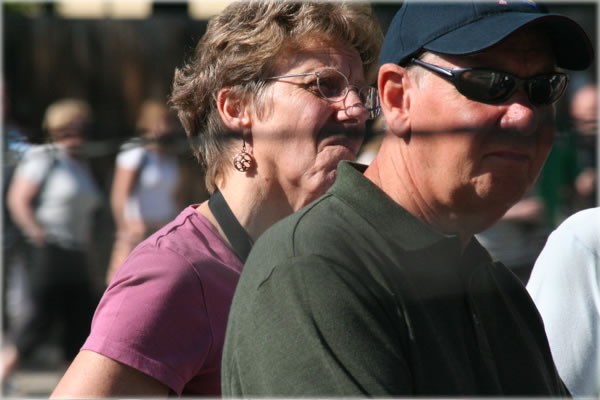 Taking it All In | Oct. 8, 2006
Taking it All In | Oct. 8, 2006
AS I left Auschwitz, the original camp, I stopped to study and photograph the reactions of people gathered near the entrance listening to tour guides tell the story. This photo, taken from inside the camp gate looking outward, pretty much sums it up: a combination of disgust and shock.
These folks look sixtyish, so what they are hearing about happened in their lifetimes or very close to it. This the thing we need to remember: the Holocaust happened recently, in a society just like ours, where a lot of middle class people wanted to enjoy their lives and not be bothered with the affairs of the government.
This is why we need to keep it in mind, and watch to see if any patterns are repeating.
One of the framers of the U.S. Constitution once remarked that the time to start worrying is not when all your rights are gone, but rather when the first of them is threatened. I have noticed that it's finally becoming less taboo to "be political," as we figure out that "political" is about OUR lives, our futures. We might want to think of more creative ways to do that, how to raise awareness and how to take action.
Tomorrow night we will begin exploring Auschwitz ii - Birkenau, and see if the history of this place, the Nazis' most cherished mass human extermination complex, holds any clues for us today. This series will remain on the cover of PlanetWaves.net and EricFrancis.com for about six more nights. Additional photos are being added to the
October cover photo gallery.
The full series, in chronological order, is kept
here.
I'll catch you tomorrow.
e
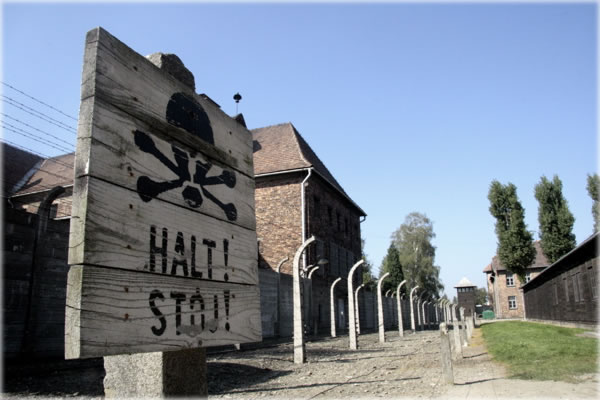 Sign before the electric barbed wire fence at the perimeter of Auschwitz, camp 1.
Sign before the electric barbed wire fence at the perimeter of Auschwitz, camp 1.
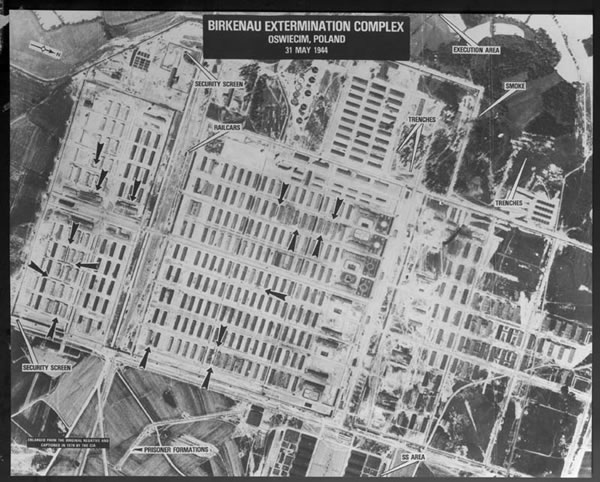 Auschwitz ii - Birkenau photo surveillance photo, 1944, courtesy of Wikimedia Commons.
Auschwitz ii - Birkenau photo surveillance photo, 1944, courtesy of Wikimedia Commons.
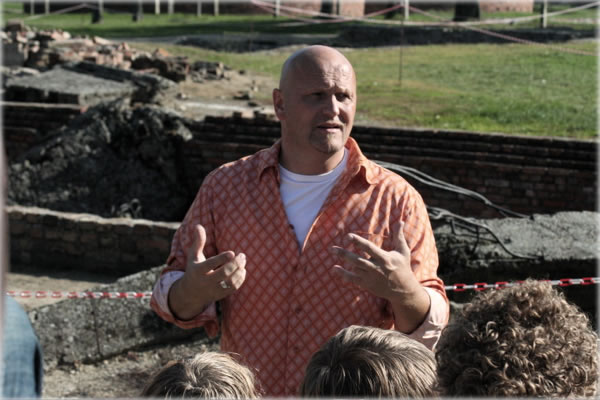 Teaching Our Kids | Oct. 9, 2006
Teaching Our Kids | Oct. 9, 2006
THE GUY in the photo above is called Leonard.
He is a minister who brings groups of kids to Auschwitz a few times a year from Norway and Sweden. There were a lot of students there the day I went, and I trust that this is pretty much true most days. For some reason, most of the students I met at Auschwitz and in Krakow were from the progressive democratic countries in northern Europe, who have made the connection between dignity, freedom and keeping the world safe from another disaster like this.
Here, in a very straightforward way, he is explaining to these students that they are in front of the ruins of gas chamber/crematorium 2, and what that means. This is at Auschwitz ii - Birkenau, the extended camp, the extermination complex. About 50 teenagers are listening attentively as he speaks. Beside us is another group going on in French. I understand enough French to know that the teacher is putting it to the students a little at a time, very tactfully, but getting the basic facts across.
Here, day after day, crowds of 1,000 or more people, most of them newly arrived by train, would go downstairs to undressing rooms, remove their clothes, and go upstairs to the "showers." They had been instructed to fold their clothes neatly and remember exactly where they left them, so they'd be able to find them when they came back. Then, together with their families and the people they had traveled with, they would be gassed to death. The chamber would be left sealed for about half an hour to make sure nobody was missed (which didn't always work).
Bodies, alive or dead, were then taken in carts on little tracks to the crematoria and incinerated in ovens up to three at a time. The ashes would be dumped in pits that are still there, where you can still find bits of bone in the nearby topsoil -- direct evidence of what happened. The reason the buildings are in ruins is because the elite Nazi SS men, who ran the camp system, dynamited them just before the camp was liberated, in order to hide the evidence of their crimes against humanity. That kind of gesture is seen more of an admission of knowing it was wrong.
From 70% to 75% of the new arrivals at Auschwitz ii - Birkenau were killed immediately. The rest, the strongest among them, were allowed to live for about a month, and do their part in the German war effort, whether it was forced labor or taking part in "scientific" experimentation. We need to pause and remember that these survivors lived out their short lives knowing that the rest of their families, with whom they arrived, had gone to the ovens.
Toward the end of the war, there was a rubber factory called Auschwitz iii - Monowitz that used prisoners in an industrial setting; a concentration camp combined with a factory. This served for the Buna-Werke factory of the IG Farben concern*. There were many of these. We need to add slave labor to the list of Nazi atrocities.
Leonard explained about a place at the camp called Canada, which was where everyone's baggage was sent, and there, sorted through for valuables (most of which were put into to the war effort). Many of the suitcases had some food in them. So the camp inmates who worked at Canada were the well-fed ones, as opposed to those who survived their remaining month of life on bread, margarine, and broth made from rotten vegetables.
Apparently, those in Auschwitz considered the nation of Canada to be their idea of the safest haven in the world. So the part of the camp where you would actually get to eat and do reasonable work was named for their utopia.
I didn't see this place, or the museum that was made from its contents: a lot of belongings of a lot of people. People disappearing by the thousands from the streets of Paris, vanishing from Amsterdam, being vacuumed off the roads and countrysides of Romania and the Baltic states, kids being collected from hospitals and put on trains, families being shipped in from Warsaw, and so on. There are mountains of prosthetic limbs, hair (of women, shaved off prior to gassing) which was sold into the war effort, recycled into some product), family photos, clothing...
When I visited Buchenwald some years ago, they had a display, in a glass case about 18 inches wide and 20 meters long, of coat buttons. You would walk by this thing and see an endless variety and endless quantity of coat buttons going by, and you would get the point quickly.
We could be extremely polite and call it human harvesting. It
is kind of how we treat most animals, particularly food animals -- if you want a graphic comparison. They actually had people sleeping on straw. Not straw mats, straw, like sheep and pigs, thrown on the floor. But there is another word for it, which is genocide.
The question that nobody has answered to satisfaction is "how does this happen?" But that should not keep us from asking, because it happens often enough; in some odd way it seems endemic to the human condition that, fairly soon, somewhere in the world, somebody is going to start a genocide. We know enough about what happened to be able to break it down to details, events and developments; we know enough about the politics and the social psychology to recognize it, and see it in action. The reasoning processes are easy to spot. One of them is, "These people are not human so we're doing everyone a big favor by killing them." Then add, "If you don't support us, you could be next."
There just seems to be a fairly wide-scale refusal, as there was in Europe during the war, to admit what is happening when it's happening. Could we really torture and bomb Muslims if we also admitted their humanity? Could it be glorified on TV, if we revealed their real agony and loss, and actually felt it? Or do
we let ourselves get away with it by figuring well, these are bad people.
As I proposed earlier, the real problem with the Nazis was that they were liars. Everything else that followed came from that one quality. You could not do something like this in an atmosphere of truth, which is why it's important to tell the truth. This is a tall order in politics, I know. Because truth is somewhat difficult to establish, and often subject to debate, it is sometimes difficult to identify lies and liars. But it's also very easy to lie. Yet it would help a lot if people did not find it so comforting to be lied
to -- which is a big part of why it's so easy. We must develop a distaste for this, and connect with the appropriate rage that would be a healthy response to deception.
And we need to teach our kids. I was taught to be aware of this subject by Ira Zornberg, my social studies teacher at John Dewey High School, who was also the first person who recruited me to be a writer on a serious journal. The Holocaust Education Center at Dewey had the role of being the place within the New York City school system where elementary school kids would come and see films and hear discussions of what happened during the Second World War in the 1930s and early 1940s. The discussions were led by other students, mainly Mr. Zornberg's specially trained social studies students.
This is a tradition we have to keep alive. It was really good to meet Leonard. The guy felt like a brother. And I had some excellent discussions with his students as we walked around the memorial at the back of the camp, between crematoria 2 and 3. Some of them wanted to know what I was doing there, and I said, well, I went to this really progressive high school and just like you, we were made aware of the truth, and it stuck.
--
Today is the anniversary of the death of Oskar Schindler.
--
*I just looked up IG Farben in Wiki - link provided below, one of the most disturbing Wiki entries I've seen. Farben was the principal Nazi corporation that had a near monopoly on chemical production in Germany during the war, and which owned the patent on Zyklon B gas. The Nazis were part and parcel of IG Farben, to the point where chemical factories in conquered territory were turned over to the company, which in turn did work for the war effort, for profit. (This is why fascism is also called corporatism.) After the war, the company was broken up; three of the units survive today. One of the units became BASF, which makes recording tape and many other products. BASF appears in the history of dioxin, as one of the worst offenders (there is something called the Badische incident, infamous in dioxin history, where people were contaminated). Agfa we've all heard of -- you can buy their film in drug stores today. Bayer sells their products in every 7-Eleven and supermarket in the world.
http://en.wikipedia.org/wiki/IG_Farben
http://en.wikipedia.org/wiki/BASF
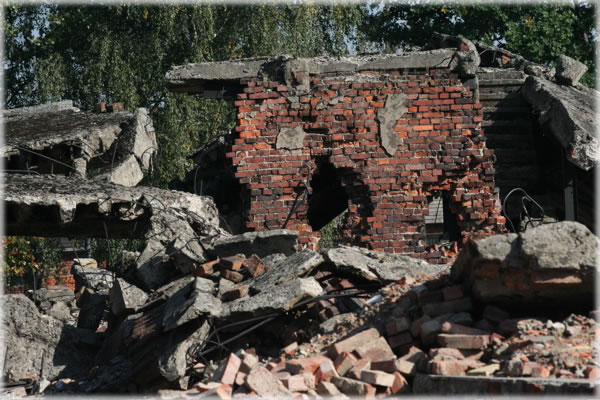 Ruins of gas chamber and crematorium unit number three at Auschwitz ii - Birkenau, near Krakow, Poland. Photo by Eric Francis, Oct. 2006.
More photos October photo gallery or here. In the end, there is no difference between the varieties of state-sponsored, corporate-backed mass poisoning, except for how fast it happens.
Ruins of gas chamber and crematorium unit number three at Auschwitz ii - Birkenau, near Krakow, Poland. Photo by Eric Francis, Oct. 2006.
More photos October photo gallery or here. In the end, there is no difference between the varieties of state-sponsored, corporate-backed mass poisoning, except for how fast it happens.